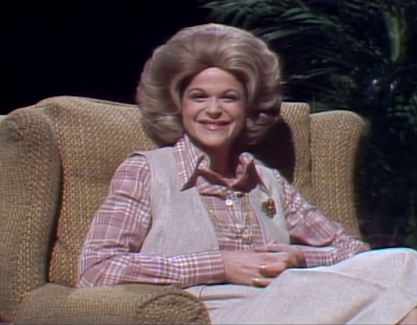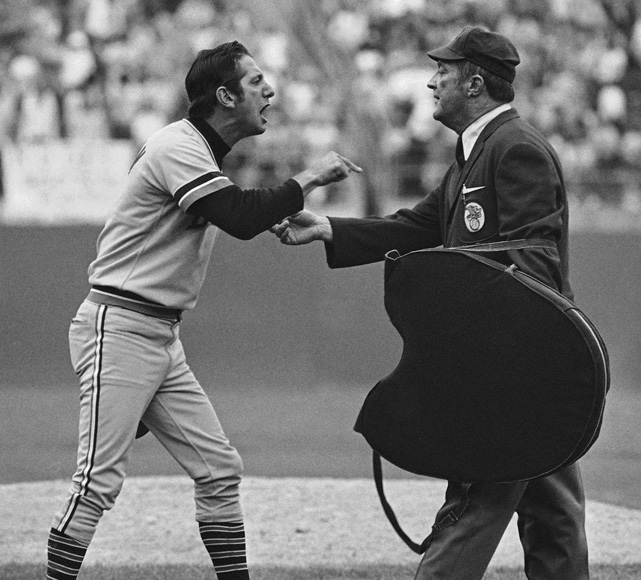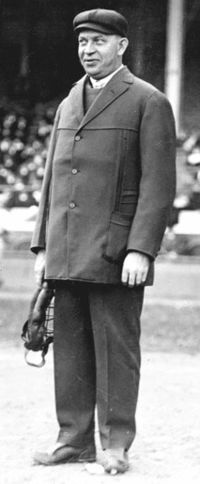
As co-host of NBC’s “Today Show” between 1962 and 1976, Barbara Wal- ters built a reputation as a tough interviewer — most of which turned to fluff when she moved to ABC and switched to pitching softball questions.
BARBARA WALTERS RETIRES;
HER CHATTY INTERVIEWS
DOMINATED TELEVISION
The Baltimore Sun’s takeover
of Maryland’s print media
is bad news for journalism
NEW BROOKS ROBINSON BIOGRAPHY
FAILS TO COME THROUGH IN CLUTCH
Umpires overruled by technology
By David Maril
While wondering if there’s still room on over-the-air network television for lengthy, sit-down interviews, it’s interesting to note the following on a variety of topics:
![]() Whether or not you are a fan of Barbara Walters’ overbearing, chatty personal style, give her credit for perseverance and a long, high-profile media career.
Whether or not you are a fan of Barbara Walters’ overbearing, chatty personal style, give her credit for perseverance and a long, high-profile media career.
Say what you want about Walters, who retired Friday from her daily television show “The View,” she remains a significant TV interviewer who landed hundreds of headline-grabbing newsmakers and personalities for lengthy one-on-one sessions.
Her retirement from full-time duty is a good time to raise the question of when it became acceptable for network television to edit so tightly the responses of guests appearing on “sit down, exclusive one-on-one” news-program interviews.
When you watch some of the guests on “Face The Nation,” “Meet The Press” and “This Week” being questioned, it’s easy to see that many of the responses are shortened and drastically edited.
While the practice eliminates extraneous rhetoric, there’s a loss of any feeling of live spontaneity and can give the impression the network is censoring to push its own talking points. The result can be a choppy, somewhat disjointed interview and makes you wonder what was left out.
If guests have so little of significance to say, why are they even on these programs in the first place?
![]() It was not good news for Baltimore and the State of Maryland when it became evident recently that the conglomerate that owns The Sun is buying up practically all the print competition in the state.
It was not good news for Baltimore and the State of Maryland when it became evident recently that the conglomerate that owns The Sun is buying up practically all the print competition in the state.
The latest acquisitions are the Baltimore City Paper, The Capital in Annapolis, the Carroll County Times and some affiliated publications.

By the time she left the “Today Show” in 1976 to become co-news anchor on ABC, Walters was so well-known that “Saturday Night Live”’s Gilda Radner caricaturized her — as “Baba Wawa” (c.1979) — on late-night television.
At last count, the Baltimore Sun Media Group, which is part of the Tribune Company national conglomerate, now locally controls more than 30 papers, seven magazines and a number of websites, claiming to reach more than one million Baltimore-area readers.
While The Sun has made impressive strides in the last couple of years, solidifying its local reporting and maintaining a quality level of sports coverage, the reality of one company owning so many state outlets for print journalism is deeply disturbing.
Despite promises of editorial independence, there’s a danger of stifling freedom of the press when the business and upper management levels are both under one roof.
In spite of lackeys for the ownership gushing about “combined resources” and the ability to serve readers better, just the opposite in such cases usually turns out to be true. It may take a few years, but in the end the consolidation eventually means elimination of jobs and a reduction in the number of diverse voices.
Some will defend the purchases, saying they are the only way these publications could financially survive.
Maybe that’s true. However, anyone who knows anything about covering news realizes that competition is the lifeblood of journalism. When you have competition, journalists are tenacious about researching stories, investigating issues and covering news more comprehensively because they want to report something first and do it better.
In this regard, look at how drastically the newspaper terrain has changed in Baltimore over the last 28 years. We’ve gone from three daily papers to just one.
And that survivor, The Sun, doesn’t even compete much anymore with the Washington Post. The two newspapers share coverage of regional and sports stories.

The Baltimore Sun has bought up all the small newspapers in the metropolitan area within a 50-mile radius of the city and beyond.
It’s sad to consider that the Baltimore Sun newspaper, which used to have its own foreign bureaus all over the world covering international news, doesn’t even produce all of its own pages.
It’s pitiful, to save a few bucks, that the Tribune conglomerate, The Sun’s owner, runs template pages inside its newspapers, using the same stories on national and international news.
One of the dead giveaways is that the Orioles’ box scores are buried at the bottom of the scoreboard page while the Chicago White Sox and Cubs, the Tribune’s home teams, are always featured at the top.
In reality, the only thing International about The Sun these days is that its customer service people you complain to when your newspaper isn’t delivered, are in the Philippines.
That must make it tricky when the newspaper is covering the issue of the high unemployment rate in Baltimore.
![]() One final knock against The Sun is, you can’t help but wonder if the newspaper’s business partnership with the TV show “House of Cards” plays a part in the extensive coverage the series generally receives on the entertainment and features pages.
One final knock against The Sun is, you can’t help but wonder if the newspaper’s business partnership with the TV show “House of Cards” plays a part in the extensive coverage the series generally receives on the entertainment and features pages.
The Netflix TV series rents space in the Sunpapers’ building on North Calvert Street.
![]() Books on Brooks Robinson are always welcome. Who wouldn’t want to read anything written about the most popular, and nicest, baseball player to ever wear the uniform of the Baltimore Orioles?
Books on Brooks Robinson are always welcome. Who wouldn’t want to read anything written about the most popular, and nicest, baseball player to ever wear the uniform of the Baltimore Orioles?
Brooks, who turns 77 today (Sunday, May 18th), remains the all-time positive image of Baltimore’s major league franchise.
Even so, one has to wonder why writer Doug Wilson put such effort into putting together the recently released Brooks: The Biography of Brooks Robinson, a dry, 293-page biography of the Hall of Fame third baseman.

Brooks Robinson told Voice of Baltimore in an interview several years ago he did not believe in charging fees for signing autographs. In 2011 he publicly told adoring spectators outside Camden Yards, “I have never considered you ‘fans’; I’ve always considered you my friends, more than anything else.” A 2014 biography of the former Baltimore Oriole known as the “Human Vacuum Cleaner” breaks no new ground in profiling the universally loved and admired 16-year Gold Glove winner.
The book is published by Thomas Dunne Books at St. Martin’s Press. Wilson has also written two other baseball books: The Bird: The Life And Legacy of Mark Fidrych, and Fred Hutchinson and the 1964 Cincinnati Reds.
Diehard Baltimore fans won’t mind revisiting the highlights of Brooks’ 23 seasons with the Orioles. Anyone who saw the “Human Vacuum Cleaner” play, or had the good fortune to meet him, enjoys looking back at his 16-year Gold Glove career.
The problem is there’s nothing new in the book that we have not heard before. The biography is primarily based on a ton of information gleaned from, and already published, in other books.
While Wilson also interviewed a number of Brooks’ former teammates, a couple of sports writers, and some lifetime friends, the book lacks the friendly, human spirit and personality of Brooks himself.
It has all the charm of a heavily researched doctoral paper. It’s as if Wilson was assigned a research project to prove that Brooks is a nice, genuine, well-liked superstar who never lost his humility and character.
But we already know all that. We’ve heard most of the stories before.
After a while, the structure and style of the book becomes quite tedious. Wilson’s format, while retracing through all the well-known highlights, is to make a statement about Brooks and then back it up with several quotes. His only quotes from Brooks already appear in other books and publications.
There’s also not much about the Baltimore icon after he retired as a player. And his many years as a TV colorman with Chuck Thompson and Jon Miller, when he connected with an entirely new generation of fans, is barely addressed. Plus there’s very little from Brooks himself on his perspective or philosophical reflections.
Brooks’ autobiography, “Third Base Is My Home,” originally published in 1974, is a much better source to get a feeling of Robinson as a person instead of Wilson’s well-documented but detached tribute.

New York Yankees’ Manager Billy Martin argues with legendary umpire Nestor Chylak during a 1972 playoff game against eventual ALCS champion Oakland.
![]() I know Baseball All-Star voting doesn’t affect the state of the nation and, in the overall scheme of things, really isn’t a big deal. Still, I cringe every time I hear Orioles’ announcers reading their marketing scripts, encouraging fans to vote numerous times for their favorite Baltimore players to qualify for a chance at prizes and ticket discounts.
I know Baseball All-Star voting doesn’t affect the state of the nation and, in the overall scheme of things, really isn’t a big deal. Still, I cringe every time I hear Orioles’ announcers reading their marketing scripts, encouraging fans to vote numerous times for their favorite Baltimore players to qualify for a chance at prizes and ticket discounts.
This is a cheap gimmick and baseball should put a stop to this kind of huckstering, practiced by every team. It takes away what little credibility All-Star selection still retains.
![]() Baseball’s move to implement an instant replay system this season, allowing managers to appeal a limited number of umpiring decisions, has been detrimental to the game. If the goal is to eliminate incorrect calls, achieving a flawless system, then why not go all the way and remove the umpires completely?
Baseball’s move to implement an instant replay system this season, allowing managers to appeal a limited number of umpiring decisions, has been detrimental to the game. If the goal is to eliminate incorrect calls, achieving a flawless system, then why not go all the way and remove the umpires completely?
Balls and strikes can be called with 100-percent accuracy if electronically monitored and there will be nothing to argue over. Sooner or later someone will even invent a machine to determine intent when a pitcher hits a batter at the plate.
But until this technology is developed, perfected and introduced, and we still have umpires, they should be the ones making all the calls and rulings. This business of a call being made, a manager appealing, and a stop in the action for up to several minutes while replays are viewed from a remote location, is absurd.
These delays, almost always at crucial stages of a game, kill the flow of baseball. They could even be used as a delaying tactic by a manager to force an effective pitcher to lose his rhythm and momentum.
Appeals are not as disruptive in football: The game is filled with timeouts, the clock is always stopping, and the pace is much more sporadic and choppy than baseball.
To have the umpires standing out there making calls that may be overruled destroys much of their credibility and authority. Can you imagine any of the legendary umpires of the game, like Bill Klem and Nestor Chylak, who called five World Series between 1957 and 1977 and six All-Star games, working under such a ludicrous format?

National League Umpire Bill Klem, shown here in 1914, was variously known as the “Father of Baseball Umpires” and the “Old Arbitrator.” Wm. J. Klem retired in 1941.
The best umpires commanded respect, kept the games moving along and were part of the humanizing element of baseball. Some of baseball’s most colorful moments have included debates, arguments and confrontations between umpires and managers.
If this switch into appeals and technology had always been in effect, Earl Weaver may have just as well dressed like a banker and worn a business suit, sitting quietly in the dugout rather than kicking dirt on umpires’ shoes.
On the lighter side, pity the travails of the classic baseball radio announcers if this half-baked system of umpires and technology expands:
It’s a tie game in the bottom of the ninth at Camden Yards and Chris Davis hits a ball down the left-field line that lands in the seats. Orioles’ voice Joe Angel can’t scream it’s a home run and “the Orioles are in the ‘win’ column” for sure, even if the umpire signals it’s a four-bagger.
Two minutes later a check of technology may rule the blast a foul ball.
![]() There’s no argument that Donald Sterling is a reprehensible, disgusting lowlife and the NBA is justified forcing him out as owner of the Los Angeles Clippers for his racist comments.
There’s no argument that Donald Sterling is a reprehensible, disgusting lowlife and the NBA is justified forcing him out as owner of the Los Angeles Clippers for his racist comments.
The two things I don’t understand, however, are the NAACP’s ever considering giving him a lifetime achievement award — no matter how much money he was donating — and how the NBA can legally ban him from buying a ticket to a game and attending as a fan.
davidmaril@voiceofbaltimore.org
“Inside Pitch” is a weekly opinion column written for Voice of Baltimore by David Maril.
EDITOR’S NOTE:
When the Baltimore Evening Sun was being published — it folded after 85 years in 1995 — the papers’ owners, first the A.S. Abell Company, followed by the Times-Mirror Company of Los Angeles, maintained separate newsrooms and competing editorial staffs for the morning and evening newspapers.
It was rare for news to be shared; rather, the two staffs operated as if they worked for competing companies, the result being that the Sunpapers produced two excellent publications based on competition against each other even more so than with the News American and its predecessors, the Baltimore News-Post and Sunday American — the local Hearst publications of bygone days — and the Washington Post and Star, Annapolis Capital and Maryland Daily Record.
When the Evening Sun folded, the Morning Sun lost its competitive edge.
CHECK OUT LAST WEEK’S “INSIDE PITCH” COLUMN: click here
…and read archived Dave Maril columns by clicking here.






May 25th, 2014 - 10:25 PM
[…] move to Baltimore was approved. CHECK OUT LAST WEEK’S “INSIDE PITCH” COLUMN: click here …and read archived Dave Maril columns by clicking here. […]